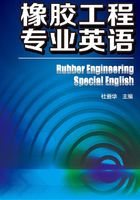
3.4 Primary,Secondary,and Tertiary Structure
A polymer chain consists of a large number of structural units which are to a greater or lesser extent mobile with respect to each other. They can therefore arrange themselves in different ways. All the processes and phenomena which can be observed in the chemistry of low molecular compounds only in a large ensemble of single molecules and which can be described generally with the aid of thermodynamics are found, in macromolecular chemistry, within the region of a single large molecule. Thus one can correctly attribute a state of aggregation to the single macromolecule and, within this meaning, speak of an intramolecular or micro-Brownian motion. In addition to this motion of single sections or segments of a chain, which may be more or less strong depending on the temperature and the chemical constitution of the chain, the entire macromolecule itself moves(intermolecular or macro-Brownian motion). The behavior of macromolecular systems is, therefore, especially complicated, not only in respect to thermodynamics(e.g., phase transitions), but also in respect to chemical reactions.
The classification of primary, secondary, and tertiary structure is to be understood as follows. The primary structure refers to the kind of structural units a chain consists of and to the sterical arrangement of neighboring structural units(cis,trans,isotactic, etc.). The primary structure of a polymer chain means the same as its chemical constitution and configuration. The primary structure affects some characteristics directly, for example, solubility and chemical behavior. It affects most properties, however, only indirectly by influencing the degree of flexibility or mobility of the chain and thus the secondary structure.
The secondary structure, in turn, determines and modifies the tertiary structure and thereby the physical behavior of the material. The secondary structure relates to the arrangement of the polymer chain within the range of a single macromolecule, i.e., conformation or the type of aggregation state of an individual macromolecule. A polymer chain can exist in a number of different shapes: as a completely extended chain, in the form of a random coil, or in the form of a periodically regular arrangement of chain segments(Figure 3.4). The random coil is, at least with synthetic polymers and with polymer solutions, the predominating type of secondary structure. Its characteristic attribute is the average coil density, which in solution is exactly proportional to the viscosity number and the molecular weight.

Figure 3.4 Schematic representation of secondary and tertiary structures of macromolecules
The tertiary structure, which is strongly influenced by the secondary structure, is concerned with the arrangement of the macromolecules to form more complex aggregates. As Figure 3.4 shown, a large variety of tertiary structures is possible.
The tertiary structure can extend uniformly throughout the whole polymeric material; however, association of two or more tertiary aggregates can lead to quaternary structures, which occur quite often in nature.For example, the component of the red blood cells responsible for the transportation of oxygen, consists of particles with four subunits, which are formed in turn by a particular folding of helices.